Results 7,181 to 7,190 of 11182
LinkBacks (?)
-
12-26-2016, 11:32 AM
-
09-02-2016, 05:39 PM
-
whole garden made with pallets!! Love it!! | Pallets | Pinterest | Pallets, Pallets Garden and Wooden Pallets
Refback This thread03-06-2016, 11:30 AM -
10-20-2015, 05:29 PM
-
06-12-2015, 08:00 PM
-
02-26-2015, 01:58 PM
-
01-05-2015, 04:13 PM
-
12-19-2014, 10:19 AM
-
EMERGENCY: HUGE FEMA PANDEMIC EXERCISE IN USA IN NOVEMBER, INTERNET SHUT DOWN PART OF EXERCISE | Prepare4Survival
Refback This thread12-03-2014, 10:39 PM -
Off Grid World ? Ugly Duckling Shipping Container Home Built by Artist Is a Beautiful Swan on the Inside
Refback This thread11-25-2014, 03:10 PM -
11-17-2014, 10:59 PM
-
11-13-2014, 11:18 AM
-
11-09-2014, 02:54 PM
-
10-28-2014, 11:38 PM
-
10-26-2014, 05:54 AM
-
10-16-2014, 11:28 AM
-
10-03-2014, 01:25 PM
-
10-02-2014, 09:16 PM
-
09-26-2014, 07:00 PM
-
09-26-2014, 01:56 PM
-
09-19-2014, 04:46 PM
-
09-13-2014, 05:49 AM
-
09-05-2014, 01:52 PM
-
09-01-2014, 09:39 AM
-
08-30-2014, 06:29 PM
-
08-10-2014, 06:29 AM
-
08-04-2014, 05:07 PM
-
07-23-2014, 11:14 AM
-
New Evidence on Expiration Dates | Medical Preparedness | Doom and Bloom (TM) | Doom and Bloom (TM)
Refback This thread07-22-2014, 10:10 AM -
07-18-2014, 08:37 PM
-
07-15-2014, 04:57 PM
-
07-11-2014, 01:40 AM
-
04-22-2014, 11:14 AM
-
04-18-2014, 12:57 PM
-
04-18-2014, 10:10 AM
-
04-14-2014, 12:18 AM
-
04-12-2014, 02:28 AM
-
03-02-2014, 11:43 PM
-
12-24-2013, 11:59 PM
-
12-07-2013, 11:04 PM
-
kitchen | Cob
Refback This thread11-25-2013, 03:24 PM -
10-22-2013, 10:25 PM
-
Apple Pie Braid | Sweets
Refback This thread09-26-2013, 07:58 AM -
09-02-2013, 04:44 PM
-
5 Reasons Why You May have to Bug Out Even Though You Don’t Want to | The Apartment Prepper's Blog
Refback This thread08-23-2013, 03:20 PM -
06-27-2013, 06:30 AM
-
06-23-2013, 08:11 PM
-
06-17-2013, 11:21 PM
-
05-24-2013, 05:06 PM
-
To Eat / BASIC LIST / SUGGESTED ITEMS FOR LONG TERM SURVIVAL - Page 275 - ALIPAC
Refback This thread05-01-2013, 03:49 AM
Thread Information
Users Browsing this Thread
There are currently 5 users browsing this thread. (1 members and 4 guests)
-
12-26-2022, 12:21 AM #7181
(2126) Building Root Cellar (Hobbit House) | Primitive Food Preservation at the Off Grid Cabin! - YouTube
Building Root Cellar (Hobbit House) | Primitive Food Preservation at the Off Grid Cabin!
1,627,170 views
Jul 24, 2020
25K
1.1K
Modern Self Reliance
147K subscribersIf you're gonna fight, fight like you're the third monkey on the ramp to Noah's Ark... and brother its starting to rain. Join our efforts to Secure America's Borders and End Illegal Immigration by Joining ALIPAC's E-Mail Alerts network (CLICK HERE)
-
12-26-2022, 12:24 AM #7182If you're gonna fight, fight like you're the third monkey on the ramp to Noah's Ark... and brother its starting to rain. Join our efforts to Secure America's Borders and End Illegal Immigration by Joining ALIPAC's E-Mail Alerts network (CLICK HERE)
-
12-26-2022, 01:58 AM #7183
12 Gauge vs 20 Gauge: The Shotgun Shootout
 BY AMMODOTCOM
BY AMMODOTCOM
FRIDAY, DEC 23, 2022 - 13:07
The versatility of a shotgun cannot be matched by many other types of firearms. You can select from a wide variety of gauges, barrel lengths, chokes, shot sizes, and more. This allows a shooter to utilize a shotgun for a multitude of purposes like hunting, home defense, and sporting clays.
However, all the different varieties and purposes can be overwhelming to new shotgun owners. Instead of covering every potential shotgun variation, it’s best to focus on the biggest question new shooters have, “Which gauge works best for me?”
Most prospective shotgun owners will narrow their choices down to two options: 12 vs 20 gauge.
The 12-gauge shotgun is the most effective one-gun solution for hunting, target shooting, and home defense. However, that doesn’t mean that the 12-gauge is the best choice for every situation.
In this article we will analyze the advantages and disadvantages of the two most popular shotgun options, 12 and 20-gauge.
What’s the Difference Between 12 Gauge vs 20 Gauge?
The difference between 12 and 20-gauge shotguns is their bore diameter. A 12 gauge has a bore diameter of 0.729” compared to 0.615” for 20 gauge. This means that a 12 gauge can fire larger payloads of buckshot at higher muzzle velocity at the cost of higher felt recoil.
12 Gauge vs 20 Gauge: Understanding Shotgun Gauges
If you’re familiar with shotguns, you’ll know that a lower gauge means a bigger caliber. However, if you’re new to shotguns or firearms in general, this can be a confusing concept to grasp.
Handgun and rifle calibers are defined by their internal bore diameter. A 40-caliber handgun has 0.40 inch diameter bore. This means the bigger the number, the bigger the bullet the gun can fire. However, shotgun gauges are determined by a more archaic system.
Gauge is determined by the number of lead balls with the same diameter as the barrel would add up to one pound.
For a 12-gauge shotgun with a bore diameter of 0.729” it would require twelve lead balls to equal one pound. Likewise, for 20 gauge guns, it requires 20 lead balls with a 0.615 inch diameter to equal one pound.
A Special Note On 20-Gauge Shells: Yellow is the New Black
If you’re new to shotguns you might not be aware that all 20-gauge shotgun shells are required to be colored yellow, regardless of payload.
This is to endure that a shooter does not mistakenly load a 20-gauge shell into a 12-gauge shotgun. If this were to happen, it’s possible that a 12-gauge shell loaded behind could cause the 20-gauge shell to fire inside the magazine causing catastrophic damage to the firearm and potentially the shooter.
For this reason, it has been mandated that all 20-guage shells are colored yellow to make them easily distinguishable from 12-guage shells.
Recoil
 When it comes to felt recoil, 20-gauge shells win by a country mile. As 12 gauge shells pack a heavier payload of projectiles and powder they will always have more recoil than comparative 20 gauge ammo. This chart compares the felt recoil experienced by the shooter for three popular 12 and 20 gauge Winchester SXP hunting loads.
When it comes to felt recoil, 20-gauge shells win by a country mile. As 12 gauge shells pack a heavier payload of projectiles and powder they will always have more recoil than comparative 20 gauge ammo. This chart compares the felt recoil experienced by the shooter for three popular 12 and 20 gauge Winchester SXP hunting loads.
Less recoil gives a 20-gauge shotgun two distinct advantages.
The first advantage is the comfort factor to the shooter. Although felt recoil will be different between shooters, the low recoil impulse that the 20-gauge shells impart on its user’s shoulder often results in increased accuracy. Less recoil means that it is less likely for a shooter to develop a flinch or raise their head off the stock just prior to firing.
The second advantage is speed of follow-up shots. Regardless of whether you need to line up two quick shots on a pheasant you just kicked up or if you need to perform a mag dump in a self-defense situation, the lighter recoil of the 20 gauge makes this an easier task.
Accuracy/Pattern Density
To understand pattern density, it’s important to understand how a shotgun ammunition works.
A shotgun shell, or shotshell, is a plastic hull with a primer at the bottom. Inside the hull is a powder charge and on top of that is a plastic cup known as a “wad” to hold the projectiles known as “shot” which are essentially just round steel or lead balls.
Shot sizes will vary depending on what you’re planning on using the shotgun shell for. For self-defense you would want to use something larger like #00 buckshot (pronounced “double aught”), or if you’re hunting something smaller, like grouse or pheasant, a smaller option like #8 birdshot would be ideal.
One common misconception is that once the wad and buckshot leave the shotgun barrel, it behaves like a swarm of bees and scatters quickly. However, what happens is that the shot leaves the barrel in a column and begins to disperse.

Shop 20 Gauge Shotgun Shells
There are numerous factors that affect how the projectiles disperse, such as minor imperfections on the surface of the shot, muzzle velocity, and stringing.
Stringing is a process where the shot at the top of the wad is deformed less during firing, while shot at the bottom of the wad endures the added pressure and weight of all the shot above it causing it to deform. This means that the buckshot at the top of the column will reach the target faster (because it’s more aerodynamic) than the shot at the bottom of the column.
The width of dispersion of shot when it reaches the target is referred to as pattern density. If the patter density is too wide, it’s possible to miss a smaller bird like a quail, at range. Conversely, if the pattern density is too tight it will be harder for shooters to score hits.
One other factor that can affect pattern density is the type of choke used in the shotgun barrel. A choke typically screws into the barrel and acts like a forcing cone, making the lead or steel shot a more compact column as they exit the barrel. Chokes will create a tighter pattern density but should not be used with slugs.
As the 12 gauge has a wider bore diameter, it can fit more shot into a wad. This means that it will have a higher pattern density than 20 gauge shot.
Stopping Power
The 12 gauge shotgun has been well known for its stopping power due to its effectiveness in trench warfare during WWI and in the jungles of the Pacific theatre during WWII. Furthermore, the 12 gauge Remington 870 pump-action shotgun is a favorite of law enforcement and can be found in squad cars across the United States.
There’s no denying that a 12 gauge load packs a huge punch, but how much? In the table below we compare three popular loads for both 12 gauge and 20-gauge shells.
Let’s compare the rifled slugs for the purpose of this explanation.
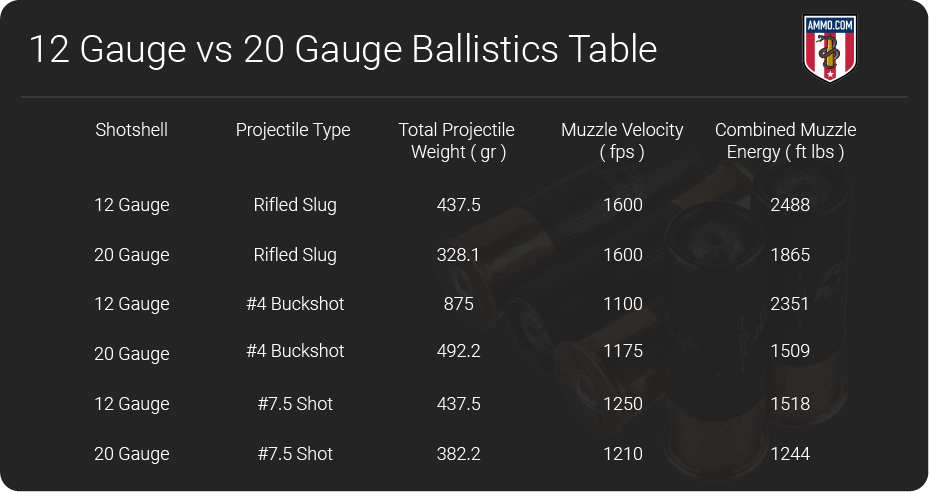 Even though both slugs exit the barrel with the same muzzle velocity of 1600 FPS, the 12 gauge load has a muzzle energy of 2488 foot-pounds while the 20 gauge load clocks in at 1865 foot-pounds (that’s a 33% difference!)
Even though both slugs exit the barrel with the same muzzle velocity of 1600 FPS, the 12 gauge load has a muzzle energy of 2488 foot-pounds while the 20 gauge load clocks in at 1865 foot-pounds (that’s a 33% difference!)
Although the disparity will vary between different loadings, 12 gauge shotgun ammunition will generally always have more stopping power than a comparative 20 gauge load.
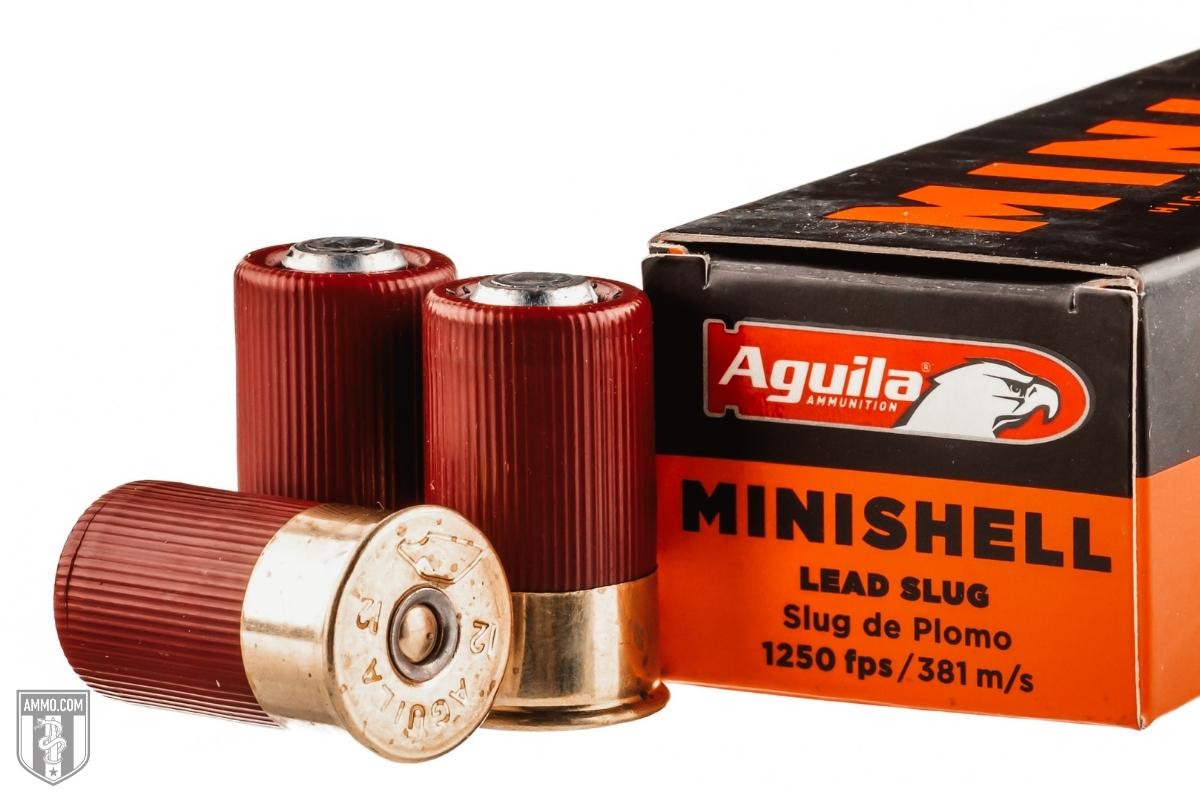
Shop 12 Gauge Shotgun Shells
Hunting
When it comes to getting into the woods for some hunting, you’ll find plenty of 12 and 20-gauge shotgun shooters in their tree stands or deer blinds in the fall.
Both shotgun gauges are extremely popular for hunting all types of game animals from upland bird, waterfowl, turkey, and even whitetail deer.
Proponents of the 20-gauge shotgun will cite its recoil advantage over the 12 gauge and suggest that it is more than sufficient for all sizes of game. On the other hand, 12-gauge aficionados will bring up the shotshell’s hard-hitting terminal ballistics and extended range that the 12 gauge offers.
Although 20-gauge loads can be effective for turkey hunting, waterfowl, and deer, the major issue is that you need to be at close range. As the 20 gauge shotshell has a lower muzzle velocity compared to the 12 gauge, the 20 will lose velocity faster and how a shorter effective range.
Therefore, the majority of hunters will grab their 12-gauge shotgun when they plan to hunt larger game animals like duck, goose, turkey, and deer. The extended range and stopping power more than make up for the additional felt recoil in most cases.
However, for small game or bird hunting, the 20-gauge is usually the best option. With its low recoil, it allows manufactures to produce a lighter gun that is quick and maneuverable. This makes it easier for hunters to quickly bring their gun to bear on a grouse or pheasant they kicked up. Furthermore, the lower recoil of the 20-gauge allows for extremely quick and accurate follow-up shots.
There’s absolutely no reason why you can’t bring your 12-gauge shotgun bird hunting as they are extremely effective. Although, if given the choice, most game hunters will opt for the lighter gun, and that’s most often a 20-gauge.
If you can only purchase one shotgun, then the 12-gauge is the best option as it does it all.

Shop 12 Gauge Shotgun Shells
However, if you have the financial capability to purchase both, a 20-gauge shotgun is an excellent choice for small game while you can still employ your 12-gauge medium to large game hunting.
Self-Defense/Home Defense
When it comes to home defense, it’s hard to be a shotgun. Although some shooters contest that a handgun is the better choice, it simply does not compare to the sheer power that a shotgun offers.
For home defense, it is inadvisable to use rifled slugs as they will typically over penetrate and could hit an innocent bystander in the home or apartment next door. Buckshot is what you want loaded in your self-defense shotgun.
There is some scholarly debate amongst ballisticians as to which buckshot is the best option for home defense. Many swear by #00 buckshot as it is considered the gold standard for self-defense, however other state that #1 or #2 buckshot is more than sufficient for any home defense situation.
If you’re unfamiliar with buckshot designations, here is a chart explaining the difference.
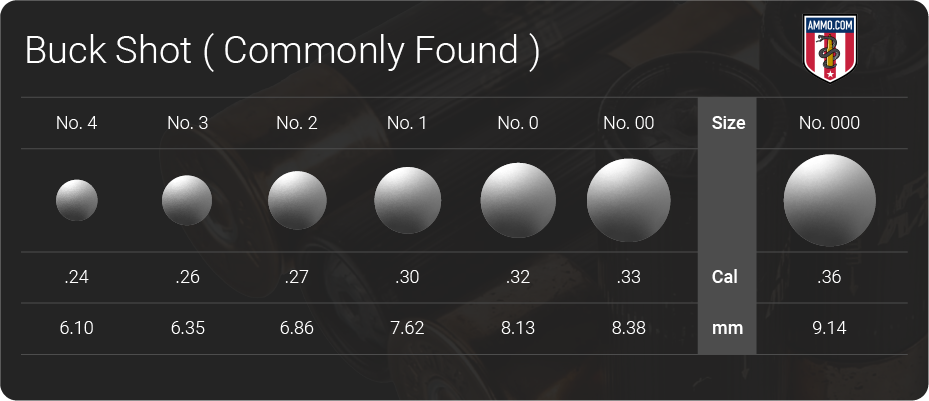 As you can see, the difference between #00 buckshot vs #1 buckshot is 0.03” in projectile diameter. This debate has been beaten to death on the Internet, however the bottom line is that any would-be home invader will likely not be able to tell the difference.
As you can see, the difference between #00 buckshot vs #1 buckshot is 0.03” in projectile diameter. This debate has been beaten to death on the Internet, however the bottom line is that any would-be home invader will likely not be able to tell the difference.
But that brings us to which shotgun would be better for home defense? 12 vs 20 gauge?
Many shooters like the feel of a 12-gauge shotgun for home defense. It’s what the military and police use and for some people, that’s all they need to know. Others like the lower recoil of 20-gauge shells and feel they are more accurate with this ammo.
For close range engagements like those in a home, it won’t make much difference which shotgun you choose. Both will be more than effective in defending your life and the lives of your friends and/or family members.

Shop 20 Gauge Shotgun Shells
Just make sure to load up with a quality buckshot (NOT birdshot or slugs) and you should be more than adequately prepared to take on any threat that enters your home and threatens your life.
Ammo and Rifle Cost/Availability
The beautiful thing about shotguns is their versatility. You have so many options, from a single shot, pump action, and even a semi-auto, the world is your oyster when it comes to shotguns.
Furthermore, entry level pump action models are typically inexpensive compared to most centerfire rifles and handguns. You can easily pick up a Remington 870 or Mossberg 500 for around $300 new in box at the time of writing.
However, this does not mean that all shotguns are so affordable. If you’re looking to get into sporting clays, skeet, or trap shooting, most competition-ready shotguns will command several thousand dollars.
Although a 20-gauge shotgun typically requires less materials to produce, there is very little difference in price between 12 and 20-gauge shotguns.
As for variety, you will not lack for options for either gauge. However, there are going to be more options for the 12-gauge as it is the most popular gauge in North America due to its versatility.
The same is true for ammo cost. Although the 20-gauge shells are smaller and require less material for construction, there is very little difference in cost between 12 vs 20 gauge.
Just like for rifle variety, you will find more options when you are purchasing 12-gauge shells as they are the most popular. There are still plenty of options for 20-gauge ammunition, just less than 12 gauge.
Buying in bulk is always smart, make sure to check out our stock of bulk 12 gauge ammo.
Reloading

Shop 12 Gauge Shotgun Shells
Reloading shotgun shells is something that many reloaders enjoy doing. However, as shotshells are relatively inexpensive, most reloaders do not bother reloading used hulls.
The cost savings for reloading shotgun shells is so low that only high-volume shooters ever worry about doing it, as it is usually cheaper just to buy new factory shotgun ammo. However, if you love the idea of optimizing your shotgun ammo, there’s nothing stopping you for loading your own shotshells.
Please note that shotshell reloading requires a specialized press that cannot be used for centerfire rifle and handgun reloading.
A Brief History of The Shotgun Shell
In their infancy, most firearms could fire a single projectile or multiple as they all had a smooth bore. Early firearms like those used by the settlers of the New World needed this versatility to survive by hunting small birds to deer with the same gun.
However, with the introducing of rifling during the mid-16th Century, rifles and shotguns became two separate entities with different purposes.
At this time, shotguns were mostly used for bird hunting but also saw use in law enforcement and protection details.
Did you ever “call shotgun” as a kid when getting into a car? This phrase dates back to the Wild West when the person sitting next to a stagecoach driver would carry a shotgun to protect the cargo or passengers from outlaws.
The first shotgun shell was introduced by the French gunsmith, Casimir Lefaucheux, in 1836. Most early shotgun shells were made entirely of brass as paper cartridges were unreliable and couldn’t be reloaded.
It wasn’t until 1960 when Remington introduced the plastic shotgun hull that is used today.
Final Shots: 12 Gauge vs 20 Gauge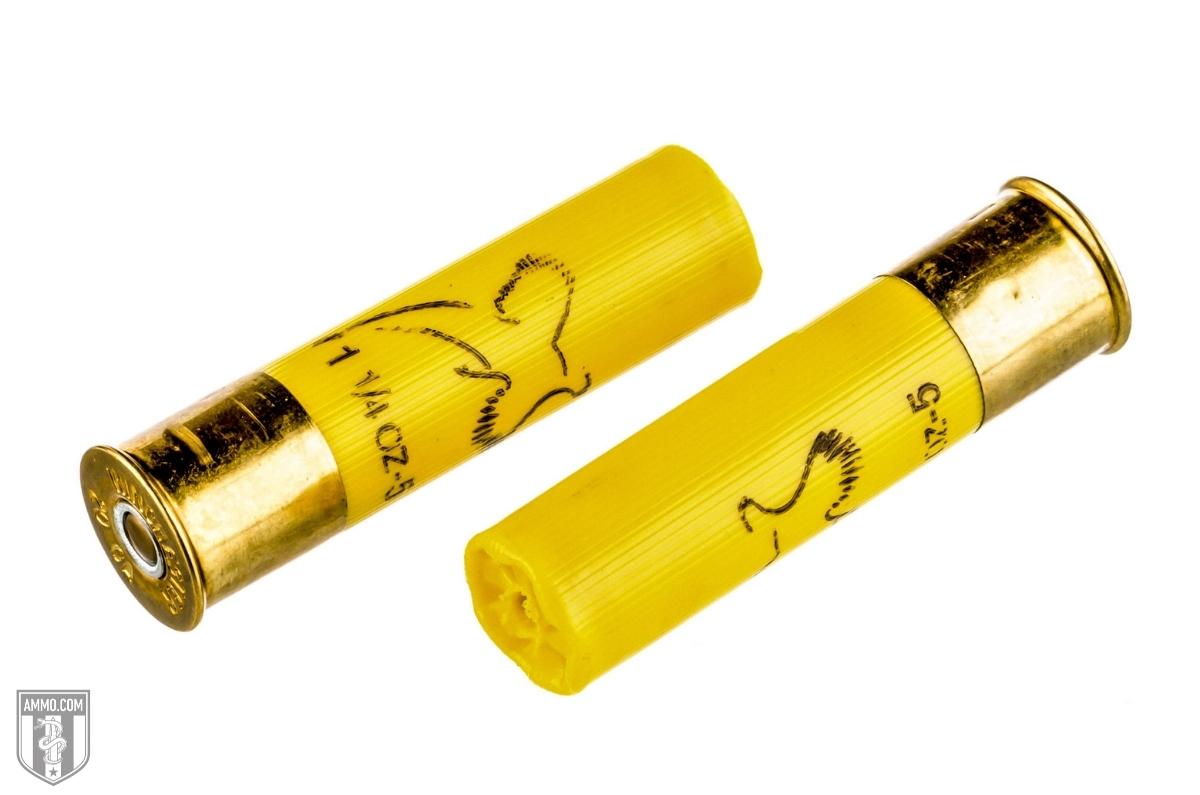
Shop 20 Gauge Shotgun Shells
There’s no denying that the 12 gauge is the “jack of all trades” option in the shotgun world. There plenty of target load options for sporting clays, trap, and skeet, heavy slugs for deer, and a variety of birdshot for turkey, waterfowl, and upland birds.
Not only is the 12 gauge a potent option for all forms of hunting, it is an extremely effective home defense option when loaded with quality buckshot shotshells.
However, just because the 12-gauge can do it all, that doesn’t mean that it’s always the best option.
The 20-gauge shotgun has proven itself to be a capable upland bird gun as it is fast, maneuverable, easy to carry, and packs enough punch to fell pheasants, grouse, and doves without issue. At close range, it can also be utilized for turkey, deer, and self-defense with proper loads. And it can do all of these things with approximately 33% less recoil than a 12 gauge.
Which shotgun gauge is best for you depends on your personal needs as a shooter. If you are recoil sensitive and only plan to hunt upland birds then the 20-gauge shotgun will be everything you need it to be.
The ideal choice would be to own both, however if you are on a budget then the 12-gauge shotgun is the best option as it does everything you could possibly want at a very reasonable price point.
12 Gauge vs 20 Gauge: The Shotgun Shootout originally appeared in The Resistance Library at Ammo.com.
Contributor posts published on Zero Hedge do not necessarily represent the views and opinions of Zero Hedge, and are not selected, edited or screened by Zero Hedge editors.
12 Gauge vs 20 Gauge: The Shotgun Shootout | ZeroHedge
If you're gonna fight, fight like you're the third monkey on the ramp to Noah's Ark... and brother its starting to rain. Join our efforts to Secure America's Borders and End Illegal Immigration by Joining ALIPAC's E-Mail Alerts network (CLICK HERE)
-
12-26-2022, 04:13 AM #7184If you're gonna fight, fight like you're the third monkey on the ramp to Noah's Ark... and brother its starting to rain. Join our efforts to Secure America's Borders and End Illegal Immigration by Joining ALIPAC's E-Mail Alerts network (CLICK HERE)
-
12-27-2022, 11:41 AM #7185If you're gonna fight, fight like you're the third monkey on the ramp to Noah's Ark... and brother its starting to rain. Join our efforts to Secure America's Borders and End Illegal Immigration by Joining ALIPAC's E-Mail Alerts network (CLICK HERE)
-
12-27-2022, 12:01 PM #7186
Attack On Food Supply: Mass Culling Of Chickens - Increase In Price Of Eggs
Tuesday, December 27, 2022 9:35

We have had many suspicious fires and attacks on food processing plants, hatcheries and food stores over the past couple of years. Now, it looks like the same people that told us to trust the science concerning the CONvids and the CONvid shots, are using their faux science to attack our food supply, namely chickens. Not only will this effect the prices of chickens but will subsequently effect that price of eggs as well.
The Wall Street Journal reports:
Egg prices are hitting records, driven by an avian-influenza outbreak that has killed tens of millions of chickens and turkeys this year across nearly all 50 states.
- Grab This Bucket Of Heirloom Seeds & Get Free Shipping With Promo Code TIM
- Build Your Own Food Forest & Save 5% With Promo Code TIMBROWN
- Make Your Own Fulvic/Humic Acid – Use Promo Code TIM You’ll Save $$$
- Get A Great Deal On A Satellite Phone
- Gain Cell Phone Freedom With Volta Wireless and Get Your First Month For Just $9.99 With Promo Code USA1
- Here’s A Way You Can Stockpile Food For The Future
- Stockpile Your Ammo & Save $15 On Your First Order
- Preparing Also Means Detoxifying – Here’s One Simple Way To Detoxify
- Save Up To 66% Off MyPillow with Promo Code TIMBROWN
Wholesale prices of Midwest large eggs hit a record $5.36 a dozen in December, according to the research firm Urner Barry. Retail egg prices have increased more than any other supermarket item so far this year, climbing more than 30% from January to early December compared with the same period a year earlier, and outpacing overall food and beverage prices, according to the data firm Information Resources Inc.
For supermarkets, eggs are a staple product that most consumers pick up on trips to the grocery store, similar to milk and butter. To maintain store traffic, grocers said they have been sacrificing some profits on eggs to keep prices for consumers competitive. Some suppliers are projecting potential relief in price by February or March, but cold weather could hamper production in the near term, executives said.
“We are trying to keep eggs relatively accessible,” said Dan O’Neill, director of center store and perishables at Angelo Caputo’s Fresh Markets, a chain of eight stores in Illinois.
Angelo Caputo’s bought extra-large eggs for $5.09 a dozen recently, up from $1.30 at the start of the year, Mr. O’Neill said. The grocer has for months been selling eggs for slightly above cost, he said, as wholesale prices have increased.
- Price Of Eggs Up 47% As Food Costs In US Spiral Out Of Control
- Fire Erupts At Pendleton, Oregon Flour Mill – The Latest In A Long Line Of Food Processing Facilities Fires
- Farm Supply Store That Sells Animal Feed & Fertilizer Goes Up In Massive Blaze
- Massive Amount Of Food Facility Fires In The US Over Past Year – Now, This! (Video)
Grocery prices have continued to increase this year because of what companies have said are higher costs of labor, ingredients and logistics, helping supermarkets generate higher sales and profits. Those factors have propelled egg prices, too. As eggs get more costly, some supermarkets are selling more organic eggs that are sometimes less expensive than conventional varieties, while suppliers say consumer demand has remained steady despite higher prices.
So, the prices of eggs are up. And what is the real culprit here? Mike Adams at Natural News points out:
Have you noticed all the reports this year of “mass culling” of millions of chickens and turkeys? The corporate media blames it on “avian influenza” that’s acquired from “wild birds” flying across the country, they claim. Because of these wild birds, tens of millions of chickens and turkeys have to be slaughtered, they insist.
I think it’s all a farce.
It’s a cover story to destroy the food supply and accelerate scarcity in both chicken eggs and chicken meat (as well as turkey meat).
Why do I suspect this? For starters, even the Wall Street Journal admits that a single positive test for an infection results in farmers being ordered to carry out a mass culling of their entire flock. From their story:
Entire poultry flocks are destroyed after an infection is confirmed…
So all it takes is a single infection — often diagnosed via a faulty PCR test that can be cranked up to generate false positives at will — to see millions of birds destroyed.
Astonishingly, those destroyed birds are then counted as victims of the “outbreak.”
Parse the language very carefully from this WSJ article. It says:
More than 40 million egg-laying chickens have died in the current outbreak, according to USDA data…
Importantly, it doesn’t say they died from avian influenza. They died from being culled.
Stated another way, the reason why so many birds are dead during an outbreak is because farmers are being ordered by health authorities to kill them.
The outbreak isn’t killing these birds, the farmers are doing it under orders from the health authorities! And all those murdered birds are counted as victims of the “outbreak.”
- Rockefeller Foundation’s Food & Energy Crisis Is Here
- As The West Blames Russia For Food Crisis, They Are Actually Orchestrating It
- Nothing to Be Alarmed About Here: I’m Sure That You All Have Heard of the Food Processing Plants Being Burned Down? Almost 100 of Them Since 2021
- As Food Crisis Grows, One Of The Largest Egg Factories Torched In Middle Of Night – Tens Of Thousands Of Chickens Lost (Video)
Now, it’s what Adams points out next that demonstrates the “science” of today is nothing more than quackery.
Here’s another shocking tidbit to consider in all this: Commercial chickens are frequently vaccinated against various pathogens. But some of the vaccines make the pathogens even worse. According to left-leaning PBS.org, “In fact, rather than stop fowl from spreading the virus, the vaccine allows the disease to spread faster and longer than it normally would, a new study finds. The scientists now believe that this vaccine has helped this chicken virus become uniquely virulent.”
They’re referring to a vaccine for Marek’s disease. The study being cited is published in PLOS Biology, entitled, “Imperfect Vaccination Can Enhance the Transmission of Highly Virulent Pathogens.”

The study states an obvious truth that rarely gets acknowledged: That vaccines can cause pathogens to spread more aggressively and kill more subjects because they do not prevent transmission or replication. From the study abstract: (emphasis added)
Could some vaccines drive the evolution of more virulent pathogens? Conventional wisdom is that natural selection will remove highly lethal pathogens if host death greatly reduces transmission. Vaccines that keep hosts alive but still allow transmission could thus allow very virulent strains to circulate in a population. Here we show experimentally that immunization of chickens against Marek’s disease virus enhances the fitness of more virulent strains, making it possible for hyperpathogenic strains to transmit. Immunity elicited by direct vaccination or by maternal vaccination prolongs host survival but does not prevent infection, viral replication or transmission, thus extending the infectious periods of strains otherwise too lethal to persist.
- How To Produce More Food Than You Can Eat In A Small Space (Video)
- This Couple Is Doing More Than Growing Food On Their Farm (Video)
- Catherine Austin Fitts & Corey Lynn: “Who Controls The Food Supply, Controls The People” (Video)
- Prepping 201: Gardening – Building A Food Supply For Yourself & Those In Need (Video)
- Expert In Growing Food & Surviving Under Communism: Time To Get Your Garden In Order – The Fragile Food Supply & Food for Life (Video)
- Store Up Dry Goods To Increase Your Food Supply (Video)
What the study is stumbling upon is the simpler answer to all this: Stop vaccinating the chickens and they will live longer as a whole.
Instead of vaccinating chickens against influenza or other strains, then mass murdering them by the tens of millions every time a single case of something is discovered, it would actually be more humane (and cost effective) to allow natural immunity to emerge via the process of natural selection. Chickens that get infected with influenza and die are no longer capable of transmitting it to others. Those that are naturally immune can be used to hatch more baby chick, carrying forward the immunity. Within a very small number of generations, you end up with a chicken population that’s (mostly) immune to influenza, or that can overcome such infections without dying.
Vaccines only cause more culling, including the culling of chickens that are naturally immune to avian influenza. Ask yourself this obvious question: Why would health authorities order farmers to kill birds that are naturally immune to avian influenza? The answer seems self-apparent: They are using the outbreak as a cover story to achieve depopulation of food-producing chickens, worsening food scarcity and food inflation at the same time.
Anyone noticing a trend here? As Adams rightly points out, “What they do to chickens today, they will do to humans tomorrow.”
Actually they are already doing it and men and women are eagerly complying for lots of temporary reasons for which they excuse themselves. The culling isn’t just happening among birds…
Article posted with permission from Sons of Liberty Media
Attack On Food Supply: Mass Culling Of Chickens - Increase In Price Of Eggs | Food and Farming | Before It's News (beforeitsnews.com)
If you're gonna fight, fight like you're the third monkey on the ramp to Noah's Ark... and brother its starting to rain. Join our efforts to Secure America's Borders and End Illegal Immigration by Joining ALIPAC's E-Mail Alerts network (CLICK HERE)
-
12-27-2022, 01:47 PM #7187
$3.75 for one dozen eggs!
They were $1.99 under President Trump
That corrupt evil entity Joe Biden has got to go...to prison!ILLEGAL ALIENS HAVE "BROKEN" OUR IMMIGRATION SYSTEM
DO NOT REWARD THEM - DEPORT THEM ALL
-
12-28-2022, 12:20 AM #7188
Emergency Preps From A To Z
TUESDAY, DEC 27, 2022 - 07:20 PM
Authored by Ashley Allen via The Organic Prepper blog,
Emergency preparedness is serious business but not all of our endeavors need to take on the gravity of life and death. This is a fun list, and while the suggestions are solid, it is by no means a list that covers everything you need to be prepared.
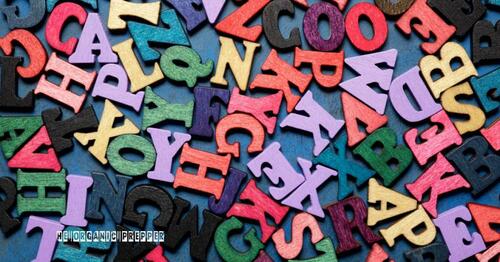
Without further ado, here’s an alphabetical list of preps that could serve you well.
Emergency Preps from A-Z
I’ve chosen one prep for each letter of the alphabet to help you get ready for disasters large or small.
A – Alcohol-based hand sanitizer: It’s important to have hand sanitizer on hand in case you don’t have access to soap and water. Alcohol-based hand sanitizer can help reduce the spread of germs and bacteria. Not a fan of hand sanitizer and prefer a natural approach? Here’s an article that explains when to use what kind of product.
B – Battery-powered radio: In the event of a power outage, a battery-powered or hand-crank radio can be a vital source of information. It can help you stay updated on weather forecasts, evacuation orders, and other important alerts. We recommend this one.
C – Cash: In an emergency, ATMs and credit card machines may not be available, so it’s important to have a supply of cash on hand. This can be used to purchase necessary supplies or pay for evacuation expenses. Put back small bills. You may not be able to get change during a crisis.
D – Drinking water: It’s important to have a supply of clean drinking water in case the water supply is disrupted or contaminated. Consider storing bottled water, or filling up jugs or other containers with tap water in case of an emergency. Here’s an article on water storage.
E – Emergency contact list: Having a list of emergency contacts can be invaluable in an emergency situation. This should include phone numbers for family members, friends, neighbors, and any relevant agencies or organizations. This is an important part of an emergency binder. Get a printable template here.
F – Fire extinguisher: A fire extinguisher can be a crucial tool for putting out small fires or containing them until the fire department arrives. It’s important to have one on hand in case of a fire emergency. Here’s an article on choosing and maintaining your fire extinguishers.
G – Generator: A generator can provide a reliable source of power in the event of a power outage. This can be especially important for those who rely on electricity for medical equipment or other essential needs. Daisy has this one for her apartment, and here’s some advice on choosing a larger one.
H – Hazardous materials kit: In the event of a chemical spill or other hazardous materials incident, it’s important to have a hazardous materials kit on hand. This should include protective gear, such as gloves and respirators, as well as supplies for cleaning up and neutralizing the hazard.
I – Insurance documents: In the event of a natural disaster or other emergencies, it’s important to have copies of your insurance documents on hand. This can help you quickly file a claim and get the financial assistance you need to recover. This printable helps you create a home inventory for insurance purposes.
J – Jacket: A warm jacket can be essential in an emergency situation, especially if you are evacuated to a location with a different climate than you are used to. It’s important to have a jacket that is appropriate for the weather in your area, as well as any locations you may need to evacuate to.
K – Knife: A knife can be a useful tool in a variety of emergency situations, including cutting through debris, opening cans, and preparing food. It’s important to have a reliable and durable knife on hand in case you need it. Here’s some advice on choosing a knife.
L – Light source: In the event of a power outage, a light source can be essential for navigating your home and performing tasks. This can include flashlights, candles, or a headlamp. This article discusses different types of emergency lighting.
M – Medical supplies: A basic first aid kit should be part of your emergency preparedness kit. This should include supplies like bandages, gauze, and pain medication, as well as any prescription medications you or your family members may need. Check out this article about OTC medications and medical supplies.
N – Non-perishable food: It’s important to have a supply of non-perishable food, such as canned goods, dried fruits and nuts, and protein bars, in case you don’t have access to fresh food. These items will keep for a long time without refrigeration and can help sustain you in an emergency situation. Here’s some advice on building your prepper food supply.
O – Oxygen tanks: If you or a family member relies on oxygen tanks for medical purposes, it’s important to have a supply of tanks on hand in case of an emergency.
P – Pet supplies: If you have pets, it’s important to include them in your emergency. Here’s a printable checklist.
Q – Quick clotting products: Quick clotting powder is a highly effective bleeding control agent that helps to stop bleeding within minutes of application. It is made from a clay-like substance that is applied directly to the wound, where it absorbs excess blood and helps to form a clot. This can be a lifesaving tool in situations where traditional methods of bleeding control, such as applying pressure to the wound, are not enough. Here’s a source of Quik Clot gauze and Celox powder.
R – Respirator mask: In the event of a natural disaster or other emergency situation, it’s possible that the air quality may be compromised. A respirator mask can help protect you from inhaling harmful particles and contaminants in the air. Here’s our guide to respirators and masks.
S – Smoke detector: A smoke detector is a vital component of any emergency preparedness plan. It can alert you to the presence of fire in your home, giving you the opportunity to evacuate or take other safety measures. Be sure to test your smoke detectors regularly and replace the batteries as needed.
T – Tent: A tent is an important item to have in an emergency because it can provide shelter in case you need to evacuate your home or if you are caught in an unexpected outdoor situation. A tent can protect you from the elements and provide a sense of security. Here are the pros and cons of bugging out with a tent.
U – USB charger: In an emergency, it’s important to have a way to charge your phone or other electronic devices. A USB charger can be a lifesaver, especially if you need to use your phone to call for help or stay in touch with loved ones. This portable charger has fantastic reviews on Amazon and is very reliable.
V – Vaseline: Vaseline is a versatile product that can be used in a variety of emergency situations. It can be used to protect and moisturize skin, as well as to seal small cuts and scratches. In a survival situation, Vaseline can also be used as a fire starter or to lubricate gear.
W – Water filter: A water filter is essential in an emergency because it can allow you to access clean drinking water if your regular source is compromised. There are many different types of water filters available, including straw filters, gravity filters, and pump filters. Choose one that is appropriate for the situation you may face. We recommend a gravity-fed water filter for home use and a Sawyer Mini or Lifestraw when you’re on the go.
X – X-Acto knife: An X-Acto knife is a precise cutting tool that can be used to cut through a variety of materials, including paper, fabric, and plastic. It can be especially useful in an emergency if you need to cut through small items or make precise cuts.
Y – Y: Yellow rubber cleaning gloves – You know the kind – your mother and grandmother swore by them to protect their hands when doing dishes. Yellow rubber gloves can be worn when handling hazardous materials, cleaning up after an emergency, or handling human waste.
Z – Ziptop bags: Ziptop bags are a useful item to have in an emergency because they can be used to store and protect a variety of items. They are great for organizing supplies and keeping them dry, and they can also be used to store food or other perishable items.
Emergency Preps From A To Z | ZeroHedge
If you're gonna fight, fight like you're the third monkey on the ramp to Noah's Ark... and brother its starting to rain. Join our efforts to Secure America's Borders and End Illegal Immigration by Joining ALIPAC's E-Mail Alerts network (CLICK HERE)
-
12-29-2022, 12:18 AM #7189If you're gonna fight, fight like you're the third monkey on the ramp to Noah's Ark... and brother its starting to rain. Join our efforts to Secure America's Borders and End Illegal Immigration by Joining ALIPAC's E-Mail Alerts network (CLICK HERE)
-
12-29-2022, 12:42 AM #7190If you're gonna fight, fight like you're the third monkey on the ramp to Noah's Ark... and brother its starting to rain. Join our efforts to Secure America's Borders and End Illegal Immigration by Joining ALIPAC's E-Mail Alerts network (CLICK HERE)


 226Likes
226Likes LinkBack URL
LinkBack URL About LinkBacks
About LinkBacks




 Reply With Quote
Reply With Quote


Swalwell threatens to revoke driver's licenses of masked ICE...
01-02-2026, 10:34 PM in General Discussion